#African Civilization
Text
When the World Was Black: The Untold History of the World's First Civilizations, Part One: Prehistoric Cultures - Supreme Understanding
Download for FREE from Z-LIB
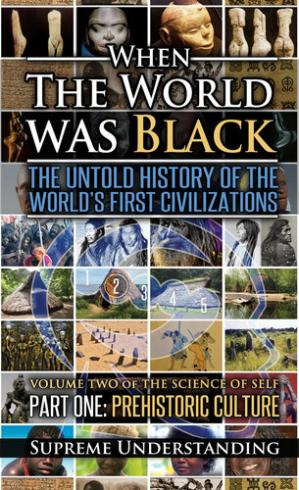
In this book, you'll learn about the history of Black people. I don't mean the history you typically learn in school, which most likely began with slavery and ended with the Civil Rights Movement. we're talking about Black history BEFORE that. Long before that.
In this book, we've covered over 200,000 years of Black history. For many of us, that sounds strange. We can't even imagine what the past of Black people was like before the slave trade, much less imagine that such a history goes back 200,000 years or more.
Download for FREE from Z-LIB
#When the World Was Black: The Untold History of the World's First Civilizations#Part One: Prehistoric Cultures#Africa#African Civilization#world history#African History#Black History
35 notes
·
View notes
Text

Sheikh Anta Diop, great defender of Black Egypt and African civilization!
18 notes
·
View notes
Text
3 notes
·
View notes
Text
These Mighty Pyramids Were Built By One of Africa’s Earliest Civilisations! The Mysterious Rulers of Nubia, in Present-day Sudan, Erected Hundreds of Tombs and Temples that Rival Cairo’s.
— By Emma Thompson | 29 December 2022 | Photographs By: Nichole Sobecki
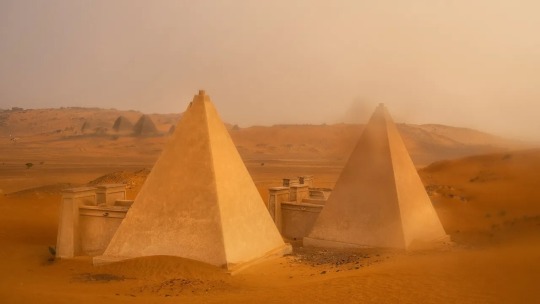
A “haboob” (sandstorm) rolls across the Meroë pyramids in Sudan. Most of the 41 tombs here belong to the royals of the powerful Kingdom of Kush (900 B.C. to A.D. 400), which ruled large parts of the middle Nile Valley.
Powered by agriculture, ancient Sudan’s great civilisations thrived and erected mighty temples and tombs honouring their gods, kings, queens, and nobles. Their building boom left behind some 255 pyramids—more than twice the number Egypt constructed next door.
Yet few Western travellers have seen these hulking sandstone relics. That’s because Sudan’s tourism industry has been impeded by two civil wars (1956-1972 and 1983-2005) and the battle for independence that led to the creation of South Sudan in 2011.
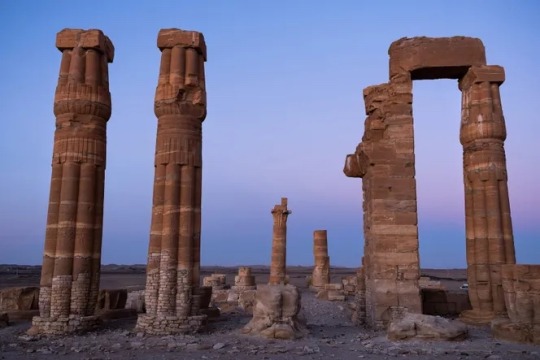
The temple of Soleb was built in the 14th century B.C. by Pharaoh Amenhotep III, in present-day Sudan. Visitors can still view its massive columns and splendid relief carvings.
Travel to Sudan is still currently not advised due to ongoing civil unrest related to a 2021 coup. However, when tensions ease, Sudan offers a singular chance to camp beside crowd-free ancient pyramids and to learn about the mysterious reign of these little-known pharaohs. A guided road trip along the Nile Valley takes you from the splendid temple at Soleb to the UNESCO-recognized Meroë, with the world’s largest cache of pyramids.
Black Pharaohs and a Once Great City
Nubia once stretched south from Aswan, Egypt, to modern-day Khartoum, Sudan. It gave rise to one of Africa’s earliest civilisations, the Kingdom of Kush, whose kings—nicknamed the Black Pharaohs—conquered Egypt in 747 B.C. and ruled the vast territory for nearly a century.
This drama played out on the banks of the world’s longest river, the Nile. Flowing south to north from Lake Victoria to the Mediterranean, the legendary waterway was considered the source of life itself because the annual flooding brought fertile soil for farming.
From the capital of Khartoum, it’s a nine-hour drive north to Soleb, Sudan’s best-preserved temple and the southernmost structure built by Amenhotep III, the Egyptian pharaoh who also commissioned the temples at Luxor. It was once guarded by the Prudhoe Lions, a pair of finely carved red granite beasts inscribed by the boy-king Tutankhamun when he visited. They are now displayed at London’s British Museum.
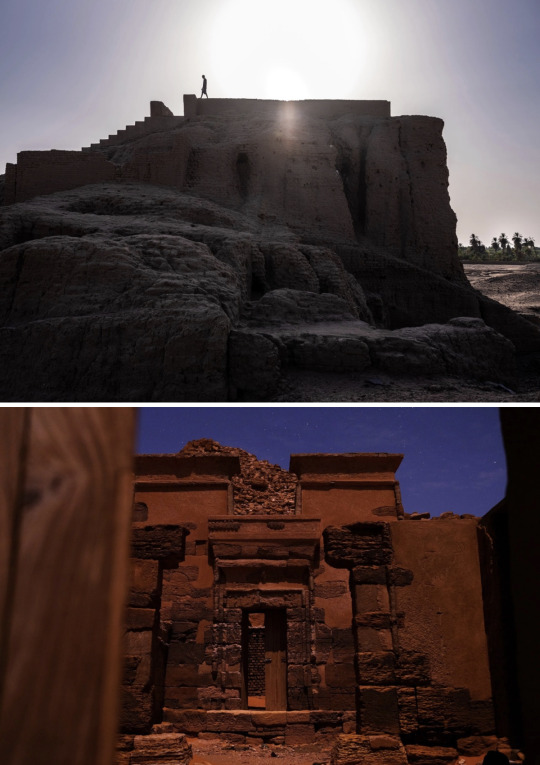
Top: Visitor Nadeem Abduraziq Mohammed walks through the ancient city of Kerma, Sudan, in July 2021. Kerma has been occupied for at least 8,000 to 10,000 years, reaching its peak around 1800 B.C., when it was capital of the Kingdom of Kush. Bottom: There are 41 tombs in Meroë’s north cemetery, 38 of them belonging to monarchs who ruled the region between B.C. 250 and A.D. 320.
Take a small barge from the village of Wawa to the western bank of the Nile, and you soon see the sandstone columns of Soleb’s main hall. Carved at their bases are images of Assyrians, hands chained behind their backs, whom the Black Pharaohs took as prisoners of war.
A few miles south of Soleb, set back from the tents where locals serve small glasses of tea beside the Nile, is Kerma. Established around 5,500 years ago, this ancient capital grew up around a huge adobe temple called the Western Defuffa. At its height the city had a population of 10,000; today, its mud brick ruins are inhabited only by nesting swallows. Nearby lies one of the oldest cemeteries in Africa.
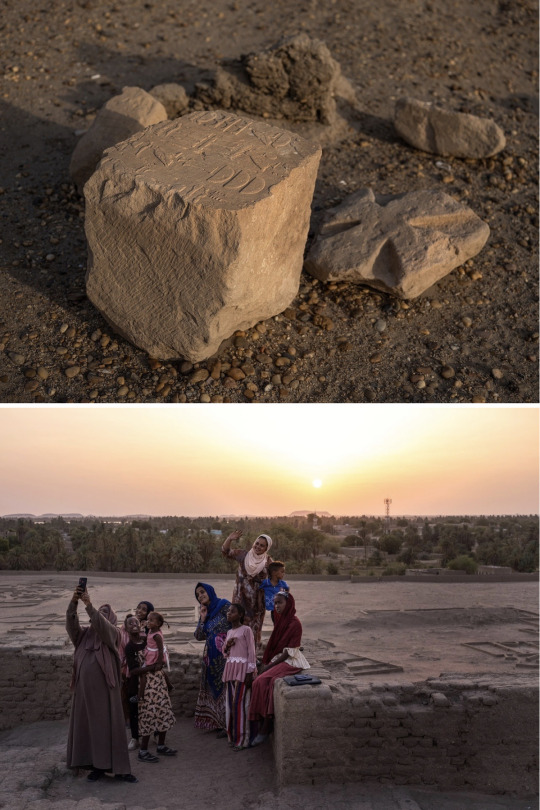
Top: A fragment of an ancient carving sits near the Kerma necropolis. This area of Sudan has been inhabited since Paleolithic times. Bottom: Tahani Abdulaziz takes a photograph of family members during a visit to Kerma.
Haunting Tombs and Dazzling Murals
Just over an hour’s drive south, and slowly being swallowed by sand, is Old Dongola. Founded with a fortress in A.D. 600, it served as the capital of the medieval Nubian kingdom of Makuria and grew to include palaces, houses, and Christian churches. It was a major stop on the Darb al-Arba’in (Forty Days Road) that thousands of camel caravans followed, transporting ivory and slaves between the Sudanese town of Darfur and Egypt.
Best preserved is the Church of the Old Granite Columns, its pale pillars framing a Throne Hall that was converted into a mosque in 1317 and remained in use until 1969. Now it’s open to visitors, along with an adjacent Islamic graveyard with distinctive 17th-century domed tombs known as qubbas.
From there, the Nile loops eastward and you come to El-Kurru, a cemetery used by the royal family of the Kingdom of Kush. Unlike in Egypt, Nubian burial chambers sit below the pyramids, not inside them.
Adobe tunnels cover the entrances to the chambers, chief among them the tomb of King Tanutamun (who died around 653 B.C.). Uneven shallow steps descend into the darkness until a flashlight click reveals a duo of domed rooms, one leading onto the other. Their white gypsum walls are covered with intricate murals in colours of ochre and yellow.
On the back wall is an arresting scene depicting Tanutamun’s heart being weighed against a feather by Maat, the goddess of truth. Kushites believed this recorded a person’s good and bad deeds and determined if the king’s soul could pass into paradise.

A Sudanese family tours El Kurru, a field of pyramids built for the kings and queens of ancient Kush.
More royal tombs crop up in Nuri, further upstream. Its smaller and steeper 70-plus pyramids are now reduced to 20. The most famous tombs belong to King Taharqa, the Black Pharoah who conquered Egypt, and King Nastasen, which archaeologists have to scuba-dive to reach because of rising ground waters.
Nuri served as the royal necropolis for the adjacent town of Napata, the first capital of the Kingdom of Kush. Both the cemetery and the ruins of the settlement lie across the Nile from Jebel Barkal, a 341-foot-tall sandstone mesa. From its summit, you can see the ruins of Nuri, including rows of cracked pillars and pairs of giant stone rams, their eyes and ears worn away by time.
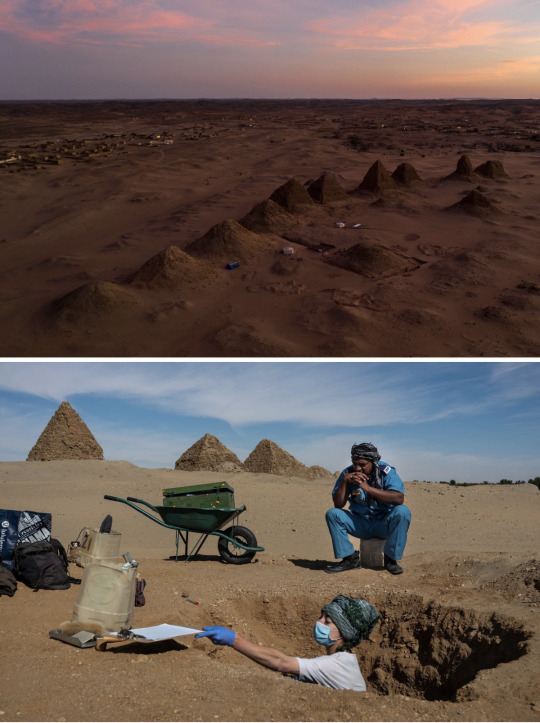
Top: The pyramids of Nuri, Sudan, were built between 650 and 300 B.C. The most famous tomb belongs to King Taharqa, the Black Pharaoh who conquered Egypt. Bottom: Archaeologist Gretchen Emma Zoeller excavates a burial site in Nuri. The ancient site sprawls across more than 170 acres along the Nile in northern Sudan.
On the western side of Jebel Barkal is a crumbling stone door frame leading to the Temple of Mut, wife of Amun. Spotlights illuminate its fine wall murals chronicling Taharqa’s coronation in white clay, ocher, and deep blue.
The World’s Largest Group of Pyramids
Finally, the Nile weaves past Meroë (pronounced Mero-way), the Kushite capital until the empire collapsed in A.D. 400 and site of Sudan’s best-preserved pyramids. More than 200 of them spread across the sands. Their granite and sandstone bases are etched with elephant, giraffe, and gazelle designs, proof that this was once fertile grasslands.
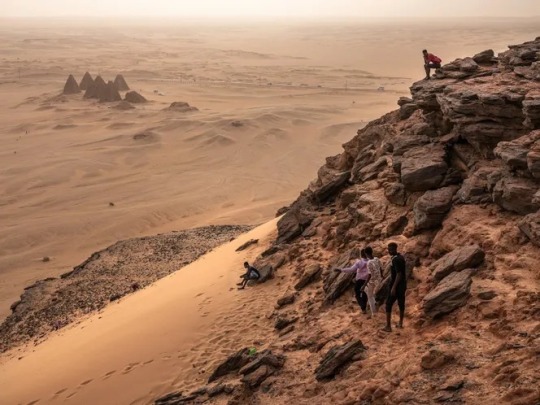
Sudanese tourists visit Jebel Barkal, Sudan, to climb the small butte, which has been considered sacred for thousands of years. Roughly a dozen pyramids are also scattered around the base of the mountain.
“It’s the biggest congregation of pyramids in the world,” reports archaeologist and Meroë site manager, Mahmoud Suliman. “At the time of the 2019 revolution, street signs, advertisements, and paintings all featured their images. It brought people together because the pyramids are so tied to our sense of identity.”
Mentioned in the writings of Herodotus, there’s an air of defiance about these structures that stand firm against the sands trying to swallow them. Indeed, it was an act of resistance that led to their construction in the first place. In the third century B.C., Kushite King Arakamani (Ergamenes) had grown tired of the Meroitic (Meroë-led) kingdom’s power-hungry high priests. So when they sent an order for him to commit suicide, he responded by having them all murdered instead.
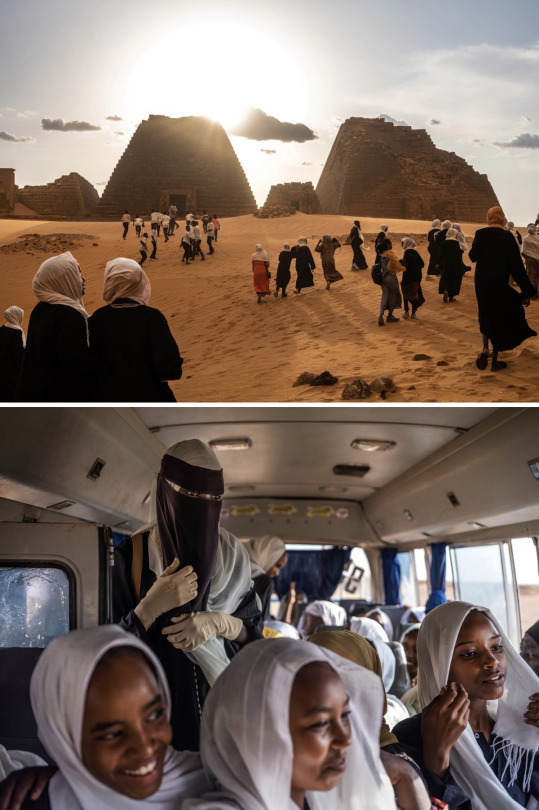
Top: A group of school children approach the pyramids at Meroë. Bottom: Volunteer tour guides show a group of Sudanese school children the Meröe pyramids. During the dictatorship of Omar al-Bashir from 1989 to 2019, Sudan’s school curriculum was infused with Islamic ideology and much of its rich ancient history was glossed over, but the new government wants to change that.
The rebellion ushered in a new era of culture: the almighty Egyptian god Amun-Ra was downgraded in favour of the lion god Abedemak, the (still undeciphered) Meroitic script was created, and warrior queens, known as kandakes, ruled the army. Inside the tombs, the carvings of the kings stand taller than the gods. You won’t see that in Egypt. Here, kings controlled everything except death.
It’s a strong message and one that’s inspired a fresh wave of national pride. For just as Ancient Greece informed so much of today’s European culture, so too did Nubia shape Sudan. It is the bedrock that formed the country’s sense of self and identity. Understanding this history suggests a way forward for Sudan.
“These were very popular kings and queens,” says Aya Allam, a Sudanese martial artist based in Khartoum. “They are a reminder that we were once a great nation and could become great once again.”
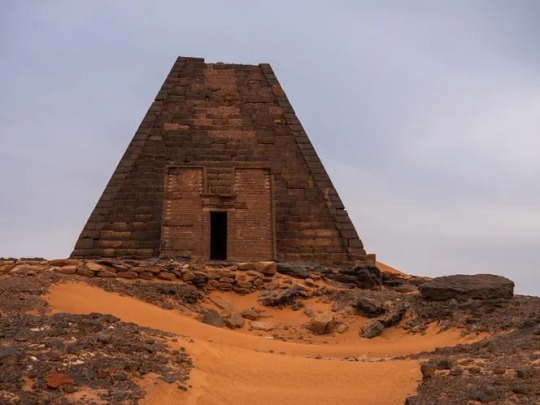
A pyramid covers a tomb in Meroë, Sudan. Rulers of the Kingdom of Kush were buried here underneath the steeply pitched structures, which range in height from 30 to one hundred feet tall, far shorter than the pyramids in nearby Egypt.
— Emma Thomson is a British Travel Writer. Nichole Sobecki is a Kenya-based Photographer.
#African Civilization#Mighty Pyramids#Mysterious Rulers#Sudan 🇸🇩#Tombs#Temples#Egypt 🇪🇬#Cairo#Emma Thompson#Nichole Sobecki#Black Pharaohs#Haunting Tombs | Dazzling Murals
3 notes
·
View notes
Text

For the ppl in the back!!
#black tumblr#black history#black literature#black excellence#black community#civil rights#black history is american history#civil rights movement#equality#equal rights#black lives matter#black pride#black people#equal#african slavery#american slavery#african american history#american history
2K notes
·
View notes
Text

Thomas Jennings was a free man born in 1791 in New York City. He was 30 years old when he was granted a patent for a dry cleaning process. In his early 20s Thomas Jennings became a tailor, and later opened a dry cleaning business in the city. As a tailor. Jennings' skills were so admired that people near and far came to him to alter or custom tailor items of clothing for them. Eventually, Jennings reputation grew such that he was able to open his own store on Church street which grew into one of the largest clothing stores in New York City.
While running his business Jennings developed dry-scouring. He had many customers complain of their clothes being ruined by stains and so he began experimenting with cleaners and mixtures that would remove the stains without harming the material. He earned a large amount of money as a tailor and even more with his dry scouring invention and most of the money he earned went to his abolitionist activities. In 1831, Thomas Jennings became assistant secretary for the First Annual Convention of the People of Color in Philadelphia, PA.
Thomas L. Jennings Dry Scouring technique created modern day dry cleaning. Jennings was fortunate that he was a free man at the time of his invention. Besides all the other indignities and cruelties slaves had to face, they were also ineligible to hold a patent. Under the US patent laws of 1793 a person must sign an oath or declaration stating that they were a citizen of the USA. While there were, apparently, provisions through which a slave could enjoy patent protection, the ability of a slave to seek out, receive and defend a patent was unlikely. Later, in 1858, the patent office changed the laws, stating that since slaves were not citizens, they could not hold a patent. Furthermore, the court said that the slave owner, not being the true inventor could not apply for a patent either.
Thomas Jennings died in New York City in 1856.
#black history#Thomas Jennings#dry cleaning#inventor#tailor#abolitionist#New York City#patent law#slavery#abolitionist activities#dry scouring technique#historical injustice#patent discrimination#civil rights activism#African American entrepreneurship#19th century America
461 notes
·
View notes
Text
#talkin#tik tok#nikki.mov#food#recipes#civil war#emancipation proclamation#african american history#happy new years#black history
422 notes
·
View notes
Text

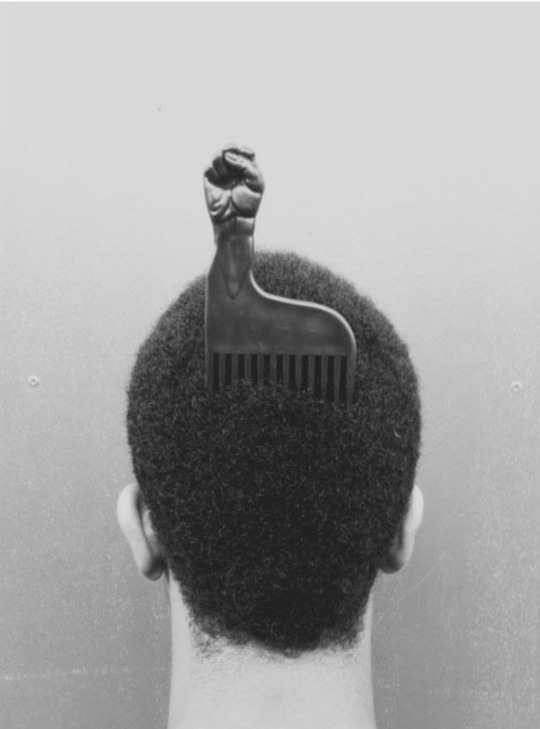
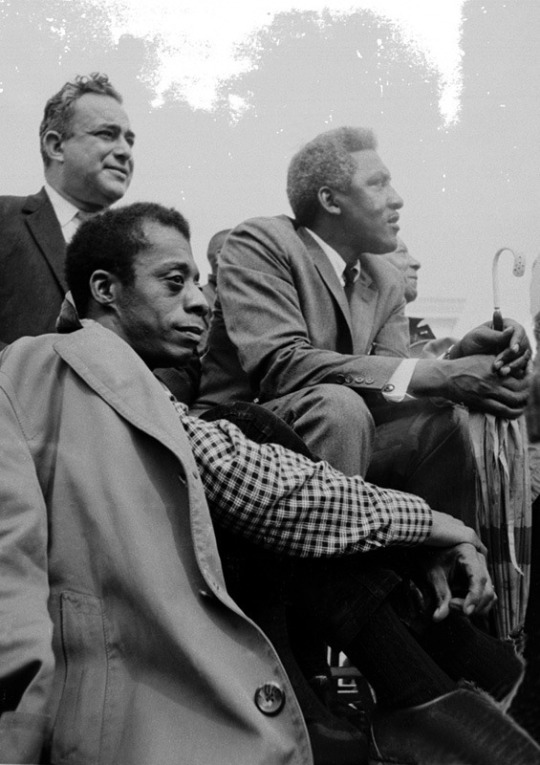



Civil Rights For All
All Black Lives Matter
#my collage#black gay men#gay#african american#lgbt#achillean#black gay magic#blackboyjoy#gay pride#lgbt pride#black pride#black men#civil rights#civil unrest#american dream#Americana#dark academia#black academia#black history#history#american history#bayard rustin#james baldwin#black gay
457 notes
·
View notes
Text

#blm#discrimination#defund the police#bipoc#black lives matter#civil rights#black lives fucking matter#lgbtqia#black lives movement#black lives have always mattered#black lives are important#black history#lgbtq#black liberation#african american history#civil rights movement#black community#civil war#civil liberties#black history month#black pride#black culture#black archives#black excellence
789 notes
·
View notes
Text

#african americans rights#african american history#underground railroad#slavery#civil war#black lives matter#civil rights movement#the narrative of the live of frederick douglass#frederick douglass#fourth of july
663 notes
·
View notes
Text

Q: Do you get off on being tempestuous?
A: “What do you mean “get off”? That’s just the way I am.”
Q: How would you like to be remembered?
A: “I want to be remembered as a diva from beginning to end who never compromised in what she felt about racism and how the world should be, and who to the end of her days consistently stayed the same.”
Q: But isn’t life about evolving and changing?
A: “Not for me.”
/ Brantley Bardin interviewing legend-with-an-attitude with Nina Simone in Details magazine, January 1997 /
Born on this day: lacerating, regal and fierce High Priestess of Soul Nina Simone (née Eunice Kathleen Waymon, 21 February 1933 – 21 April 2003). I’d argue Simone was at her artistic zenith between 1964 – 1966, when she recorded essential statements like “I Put a Spell on You”, “Work Song” (“I left the grocery store man bleeding …”), “Ne Me Quitte Pas”, “Wild is the Wind”, “Don’t Let Me Be Misunderstood”, “I Hold No Grudge” and especially “Four Women” (“I’m gonna kill the first mutha I see …”). Pictured: portrait of Simone by Herb Snitzer, 1959.
#nina simone#high priestess of soul#fierce#herb snitzer#jazz#blues#black classical music#lobotomy room#diva#kween#civil rights movement#african american
152 notes
·
View notes
Text
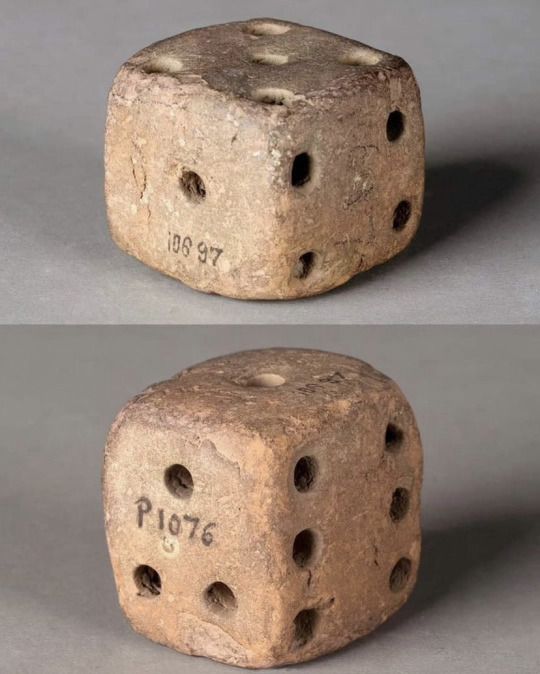
Pair of smol Terracotta dice
Harappa (2600-1800 BCE), an ancient city from the Indus Valley Civilization, modern day Punjab, Pakistan
Many were found in Mohenjo-daro as well, another central ancient city of the Indus Valley in modern day Sindh, Pakistan.
Mostly cube-shaped, sizes range from 1.2 by 1.2 by 1.2 inches to of 1.5 by 1.5 by 1.5 inches
#art#archaeology#sculpture#ancient#ancient art#harappan civilization#indus valley#indus valley civilization#african art#african culture#punjab#sindh#ancient culture
256 notes
·
View notes
Note
I know you don't usually do these kinds of posts, but you're probably one of the most implicated in black history month people that I follow so I wanted to ask you, as I already value your opinions in Acotar, what do you think of the documentary where actual historians claim Cleopatra was a black woman? Lately, this has been a pretty active topic on my fyp on TikTok, and I wanted to know a black woman's perspective on this.
Thank you in advance, and if you usually don't answer these questions or don't want to answer this one, I'll totally understand, and there's no problem at all.
I didn’t know there was a new documentary out, but when I saw the name Cleopatra I automatically sighed because I knew what was coming. This is a subject a know a little 🤏🏾 about, actually, because I researched it a bit myself in my last year of high school (and stopped because of the uh. NASTINESS associated with this particular subject) and though it’s been a few years I remembered some main, basic things, and I wanted to check a few things first.
At best, in the most CHARITABLE interpretation as far as I in my limited knowledge can tell, it would be correct to say that’s it’s POSSIBLE that she MAY have been mixed Black because, though she was part of the GREEK Ptolemaic dynasty that ruled Egypt (Ptolemy being one of Alexander the Great’s generals who got the Egyptian portion of his empire after Alexander died), that’s on her fathers side; her mother’s exact ethnicity isn’t known. Not that this won’t stop the hoteps from running off and claiming her and all of ancient Egypt as Black though So some have ***speculated*** that her mother—and thus Cleopatra—may have potentially been part Egyptian (and that goes into the issue of deciding that the “Egyptian” in this instance had to have been Black rather than MENA but that’s again a whole other can of worms). BUT it’s more likely that her mother was Greek due to the uh, PRACTICE™️ of inbreeding and it not being common for the dynasty to marry Egyptians. So it’s more probable that she was fully Greek/Macedonian and not part Egyptian, much less part Black. (Also some historians speculate she may have had Persian blood? I guess? Again it’s a can of worms, not something i’m digging deep into because of the nastiness that you often stumble across) Unless there’s a new study confirming her mother’s identity or something that I missed, it’s simply incorrect to claim that Cleopatra was undeniably Black, because though it is ***possible*** she most likely ***wasn’t.***
But this topic really upsets me, because there are LEGITIMATE Black kingdoms and empires who were mighty and well developed and powerful like the Aksumite empire and kingdoms of Kongo and Loango and the Great Zimbabwe empire and the empires of Ghana and Mali and Songhay and the Ashanti kingdom and the WHOLE SWAHILI COAST THAT WAS INVOLVED IN THE INDIAN OCEAN TRADE ROUTE and they had their own great rulers, their own kings and queens and emperors and empresses, their palaces and castles, their own cities and towns, their own complex civilizations and dynastic royal families that deserve the attention Cleopatra and ancient Egypt get. They were erased—and Egypt was not—by white people to prop themselves up as the only race capable of forming civilizations and advanced societies as a means of justifying colonization and imperialism to “civilize” the rest of the world and as a result many of those other empires have been erased from our education system here in the states and many people cling to ancient Egypt as proof that we’re not inferior and aren’t savages like white people claim due to believing that since Egypt’s in Africa it had to have been mostly Black when Egypt, and the Ptolemaic dynasty and Cleopatra in PARTICULAR, are literally the worst example that could’ve been chosen and were the only African kingdom spared erasure FOR A REASON.
Anyway, I don’t like it, it’s disingenuous and does US wrong because we need to give that energy to other African kingdoms that need and could use the fame Egypt + Cleopatra get, and we deserve a better education system to teach us this stuff. I hope this answers your question? And I don’t mind any kinds of asks 🥰
#I get the desire to claim Egypt because I remember in high school a racist white guy asked why Africans didn’t build their own civilizations#And that’s what sent me researching in the first place so I truly get the frustration but black women we can do BETTER#ask#anon#cleopatra#egypt#africa#racism#Don’t come at me in my inbox yall#antiblackness
1K notes
·
View notes
Text
5 notes
·
View notes
Text

A female protester was physically removed from a demonstration in Los Angeles in March 1965 against the shocking violence in Selma, Alabama
#usa#news#student protest#protests#history#vintage#Alabama#black history#blacklivesmatter#feminism#civil rights#tel aviv#jerusalem#Israel#UNGA#vintage photos#usa news#protest#Image#fannie lou hamer#blacktumblr#black liberation#african history
136 notes
·
View notes
Text

#black panther party#black panthers#black history#black tumblr#black literature#black excellence#black community#civil rights#black history is american history#civil rights movement#black girl magic#blackexcellence365#equal rights#black lives matter#black history matters#african american history#american history#american#black history month#black history facts
1K notes
·
View notes